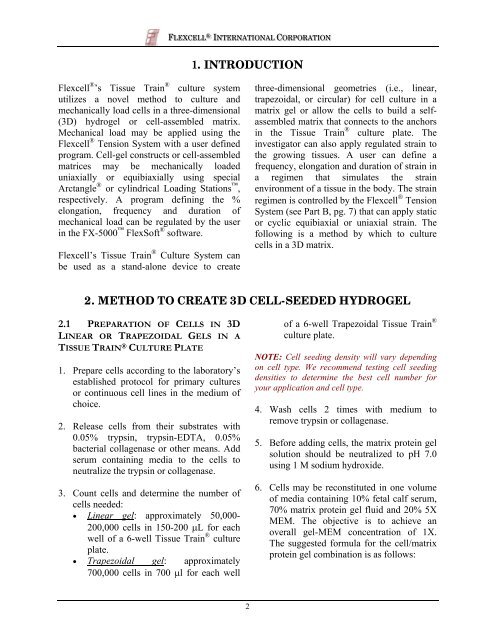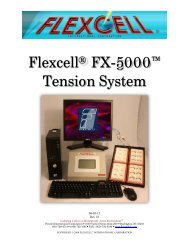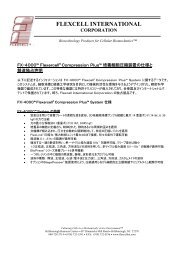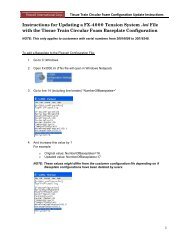Flexcell Tissue Train Culture System
Flexcell® Tissue Train® Culture System - Flexcell International Corp.
Flexcell® Tissue Train® Culture System - Flexcell International Corp.
- No tags were found...
You also want an ePaper? Increase the reach of your titles
YUMPU automatically turns print PDFs into web optimized ePapers that Google loves.
FLEXCELL ® INTERNATIONAL CORPORATION<br />
1. INTRODUCTION<br />
<strong>Flexcell</strong> ® ’s <strong>Tissue</strong> <strong>Train</strong> ® culture system<br />
utilizes a novel method to culture and<br />
mechanically load cells in a three-dimensional<br />
(3D) hydrogel or cell-assembled matrix.<br />
Mechanical load may be applied using the<br />
<strong>Flexcell</strong> ® Tension <strong>System</strong> with a user defined<br />
program. Cell-gel constructs or cell-assembled<br />
matrices may be mechanically loaded<br />
uniaxially or equibiaxially using special<br />
Arctangle ® or cylindrical Loading Stations ,<br />
respectively. A program defining the %<br />
elongation, frequency and duration of<br />
mechanical load can be regulated by the user<br />
in the FX-5000 FlexSoft ® software.<br />
<strong>Flexcell</strong>’s <strong>Tissue</strong> <strong>Train</strong> ® <strong>Culture</strong> <strong>System</strong> can<br />
be used as a stand-alone device to create<br />
three-dimensional geometries (i.e., linear,<br />
trapezoidal, or circular) for cell culture in a<br />
matrix gel or allow the cells to build a selfassembled<br />
matrix that connects to the anchors<br />
in the <strong>Tissue</strong> <strong>Train</strong> ® culture plate. The<br />
investigator can also apply regulated strain to<br />
the growing tissues. A user can define a<br />
frequency, elongation and duration of strain in<br />
a regimen that simulates the strain<br />
environment of a tissue in the body. The strain<br />
regimen is controlled by the <strong>Flexcell</strong> Tension<br />
<strong>System</strong> (see Part B, pg. 7) that can apply static<br />
or cyclic equibiaxial or uniaxial strain. The<br />
following is a method by which to culture<br />
cells in a 3D matrix.<br />
2. METHOD TO CREATE 3D CELL-SEEDED HYDROGEL<br />
2.1 PREPARATION OF CELLS IN 3D<br />
LINEAR OR TRAPEZOIDAL GELS IN A<br />
TISSUE TRAIN ® CULTURE PLATE<br />
1. Prepare cells according to the laboratory’s<br />
established protocol for primary cultures<br />
or continuous cell lines in the medium of<br />
choice.<br />
2. Release cells from their substrates with<br />
0.05% trypsin, trypsin-EDTA, 0.05%<br />
bacterial collagenase or other means. Add<br />
serum containing media to the cells to<br />
neutralize the trypsin or collagenase.<br />
3. Count cells and determine the number of<br />
cells needed:<br />
Linear gel: approximately 50,000-<br />
200,000 cells in 150-200 L for each<br />
well of a 6-well <strong>Tissue</strong> <strong>Train</strong> ® culture<br />
plate.<br />
Trapezoidal gel: approximately<br />
700,000 cells in 700 l for each well<br />
of a 6-well Trapezoidal <strong>Tissue</strong> <strong>Train</strong> ®<br />
culture plate.<br />
NOTE: Cell seeding density will vary depending<br />
on cell type. We recommend testing cell seeding<br />
densities to determine the best cell number for<br />
your application and cell type.<br />
4. Wash cells 2 times with medium to<br />
remove trypsin or collagenase.<br />
5. Before adding cells, the matrix protein gel<br />
solution should be neutralized to pH 7.0<br />
using 1 M sodium hydroxide.<br />
6. Cells may be reconstituted in one volume<br />
of media containing 10% fetal calf serum,<br />
70% matrix protein gel fluid and 20% 5X<br />
MEM. The objective is to achieve an<br />
overall gel-MEM concentration of 1X.<br />
The suggested formula for the cell/matrix<br />
protein gel combination is as follows:<br />
2








